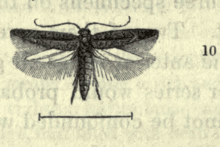Scrobipalpa instabilella
Scrobipalpa instabilella, the saltern groundling, is a moth in the family Gelechiidae. It was described by John William Douglas in 1846. It is found in on the Canary Islands, in Algeria, Ireland, Great Britain, Portugal, Spain, France, Belgium, the Netherlands, Germany, Denmark, Italy, Sardinia, Sicily, Greece, Cyprus and Palestine.[1][2] It is also present in the United States, where it has been recorded from California.
| Scrobipalpa instabilella | |
|---|---|
 | |
| Scientific classification | |
| Kingdom: | |
| Phylum: | |
| Class: | |
| Order: | |
| Family: | |
| Genus: | |
| Species: | S. instabilella |
| Binomial name | |
| Scrobipalpa instabilella (Douglas, 1846) | |
| Synonyms | |
| |
The length of the forewings is 5.6–6 mm (0.22–0.24 in). The forewings are uniform lustrous, brownish grey, with scattered ochreous scales and a weak indication of two linear rust coloured stigmata in the cell. The hindwings are pale grey.[3]
The larvae feed on Atriplex portulacoides and Atriplex halimus. They mine the leaves of their host plant. The mine is blotchlike and most frass is ejected through a small opening in the mine. Larvae may leave the mine and restart elsewhere. Pupation takes place outside of the mine. The larvae are yellowish grey with three reddish brown length lines and a light brown head.
References
- Savela, Markku (ed.). "Scrobipalpa". Lepidoptera and some other life forms. Retrieved 20 July 2020 – via FUNET.
- Fauna Europaea
- Powell, J.A. & Povolný D., 2001: Gnorimoschemine moths of coastal dune and scrub habitats in California (Lepidoptera: Gelechiidae). Holarctic Lepidoptera (Gainesville), 8 (suppl. 1): 1–53. Full article